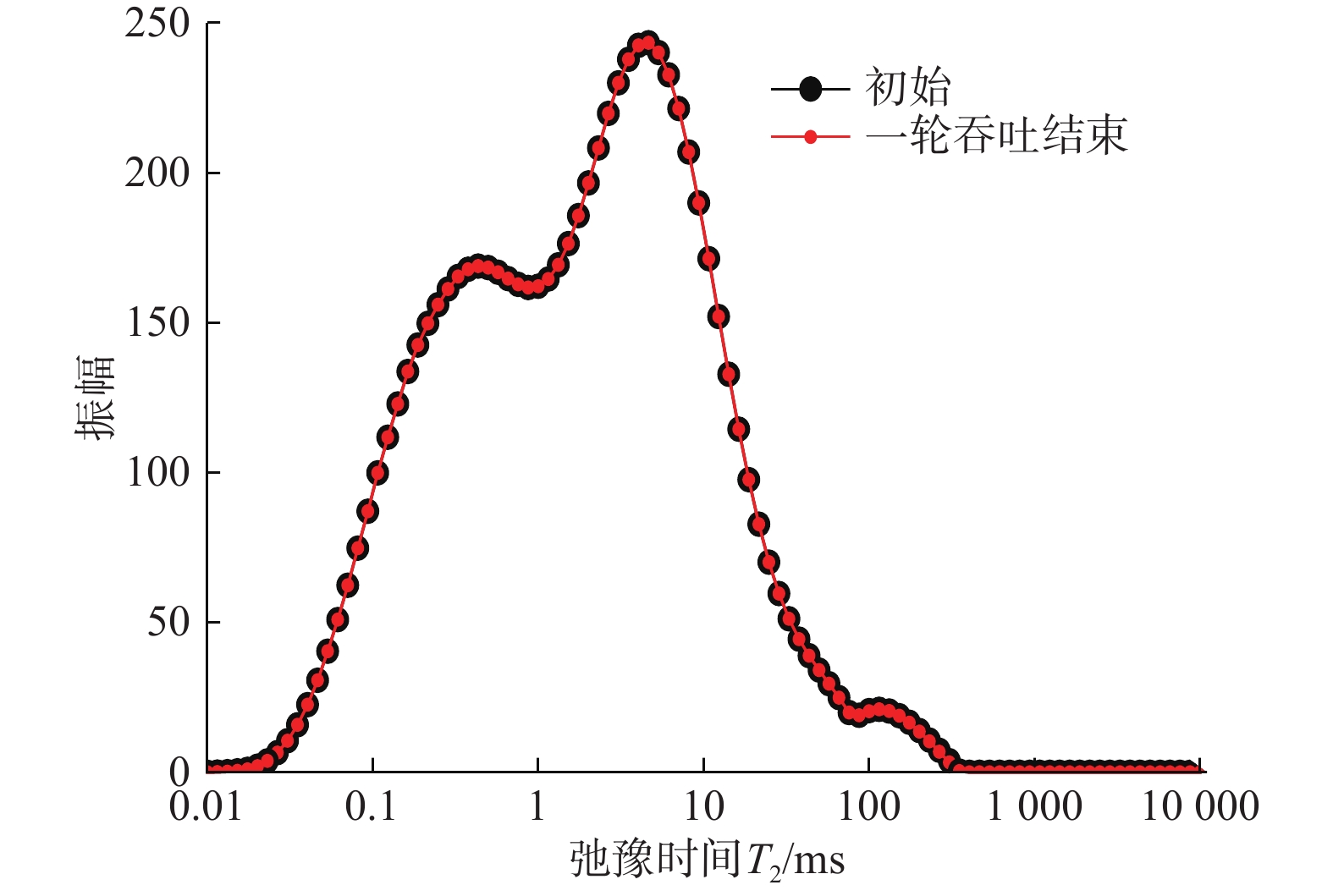Experimental Study on Foam-Assisted Gas Huff-and-Puff in the Jimsar Shale Oil Reservoir
-
摘要: 吉木萨尔页岩油藏储层渗透率极低,改造后存在大量人工裂缝和天然裂缝,采用注氮气吞吐方式开采易发生气窜,造成氮气波及范围小,页岩油采收率低。为了增大氮气波及范围、提高吉木萨尔页岩油藏的采收率,在评价泡沫封堵页岩裂缝能力的基础上,利用吉木萨尔页岩岩样进行了泡沫辅助注气吞吐试验,分析了泡沫辅助注气吞吐提高采收率的机理,研究了吞吐轮次和裂缝页岩岩样基质渗透率对泡沫辅助注气吞吐采收率的影响。研究发现:泡沫可以封堵裂缝,有效抑制气窜;当泡沫体积分数为50%、注气速率为2 mL/min时,突破压力最大,封堵效果最好;与氮气吞吐相比,泡沫辅助注气吞吐之所以能够提高采收率,是因为其不仅能够采出大孔隙和中孔隙中的原油,还能够采出微孔隙中的原油;在最优泡沫注入参数下,裂缝岩样的采收率随吞吐轮次增多而升高,但升高幅度逐渐减小;对于基质渗透率较高的裂缝岩样,泡沫辅助氮气吞吐的采收率也较高。研究结果为吉木萨尔页岩油藏采用泡沫辅助注气吞吐开发提供了理论依据。Abstract: Due to the fact that the Jimsar shale oil reservoir has low permeability and massive artificial and natural fractures, and gas channeling easily happens when N2 huff-and-puff is adopted for development, there is a problem of limited sweep range of N2 and low shale oil recovery. For a greater sweep range of N2 and enhanced oil recovery (EOR) in the Jimsar shale oil reservoir, the Jimsar shale samples were used for foam-assisted gas huff-and-puff experiments based on the evaluation of plugging capacity of foam for shale fractures. Besides, the team analyzed the EOR mechanism of foam-assisted gas huff-and-puff, and studied the influence of the huff-and-puff rounds and matrix permeability of fractured shale samples on the oil recovery by foam-assisted gas huff-and-puff. The experimental results showed that foam could seal fractures and effectively inhibit gas channeling, and when the foam volume fraction was 50% and the gas injection rate was 2 mL/min, the breakthrough pressure could reach the maximum value, with the best effect of plugging. Compared with N2 huff-and-puff, the foam-assisted gas huff-and-puff can improve the recovery of crude oil not only from the large and medium pores, but also from micropores. With optimal foam injection parameters, the recovery of fractured samples increase with the rounds of huff-and-puff, but the increasing extent will gradually fall. For fractured samples with high matrix permeability, the recovery of foam-assisted N2 huff-and-puff are also high. The results can provide the guidance for the development of the Jimsar shale oil by foam-assisted gas huff-and-puff.
-
根据预测,2035年我国非常规石油产量将超过5 000×104 t,页岩油将成为我国石油稳定发展的新增长点[1-4]。准噶尔盆地吉木萨尔页岩油田开发示范区虽取得比较好的开发效果,但采收率较低。国外大量研究表明,注气吞吐是提高页岩油藏采收率的有效技术[5-8]。页岩储层渗透率极低,改造后存在大量裂缝,注入的气体易沿着人工裂缝窜流,很难到达油藏深部,J. J. Sheng[9]研究认为只有采用注气吞吐才能发挥气体驱油的优势。注气吞吐可以避免邻井之间的气窜,从而提高了页岩油藏采收率[10]。T. D. Gamadi等人[11]利用Barnett、Marcos和Eagle Ford地区的页岩岩样进行了注N2吞吐试验,发现对于不同注入压力和不同类型页岩岩样,采收率可从10%提高到50%。Chen Cheng等人[12]分析了页岩油组分、黏度和密度对注气吞吐提高页岩油采收率的影响。Yu Yang等人[13]评价了闷井时间和生产时间对页岩岩心注气吞吐采收率的影响,发现采收率随着压力消耗速率增大而升高,经10次循环,采收率最高可达50.5%。Li Lei等人[14]研究了岩样尺寸对采收率的影响,直径较大的岩样由于其压力梯度较低、表面积与体积之比较小,采收率相对较低。
注气吞吐虽然可以提高页岩油藏的采收率,但是气体注入阶段仍会发生气窜,目前主要研究了气驱时的气窜问题解决办法,而注气吞吐和气驱抑制气窜的目的不同。气驱是气体由注入井到生产井的流动过程,抑制气窜的目的是让气体由注入井顺利到达生产井;注气吞吐是在同一口井进行注气和采油,抑制气窜的目的则是不让气体到达相邻井的储层,仅在吞吐井附近积累形成高压,促使气体进入储层。因此,注气吞吐不能采用气驱抑制气窜的技术方法。泡沫可以封堵裂缝和渗透率高的地层,有效抑制气窜,解决油藏非均质性带来的波及不均匀等问题[15-21]。大量试验和现场实践表明,注入泡沫能有效提高非均质油藏的采收率[22-28]。与其他防窜剂相比,泡沫由气液两相流体组成,更适用于页岩油藏。因此,笔者选用吉木萨尔页岩油藏岩心,以AOS为起泡剂、氮气为气相配制成泡沫,开展了泡沫辅助氮气吞吐试验,分析了泡沫抑制气窜的可行性,研究了泡沫体积分数、注气速率对泡沫封堵裂缝能力的影响,优化了泡沫注入参数。在对比有无泡沫辅助氮气吞吐条件下页岩油的采收率的基础上,分析了泡沫辅助氮气吞吐提高页岩油采收率的机理。在最优泡沫注入方式下,研究了吞吐轮次和基质渗透率对页岩油采收率的影响规律。
1. 泡沫封堵裂缝试验
1.1 泡沫封堵裂缝能力评价
页岩油藏需要压裂才能投入开发,因此要论证泡沫辅助氮气吞吐是否可以抑制气窜。首先,选用渗透率和尺寸相同的吉木萨尔页岩油藏的岩样,通过线切割的方式沿轴线位置切割获得人工裂缝(见图1);然后,选用高纯氮气(纯度大于99.9%),采用试验方法评价泡沫封堵裂缝的能力。
试验所用岩样水敏性较弱,且试验时只注入6 mL泡沫,液相与岩石的接触面积小,反应时间短,因此可以忽略岩心的水敏性。裂缝对储层产能有至关重要的影响,可以显著改善地层渗透率,并为流体流动提供通道,对低基质渗透率岩样的渗流能力影响较大[23]。裂缝开度是评价裂缝性质的重要参数,其对裂缝渗透率的影响很大。Cmexoba等人[24]建立了裂缝渗透率与裂缝开度的关系式:
Kf=cb3LS (1) 式中:Kf为裂缝渗透率,mD;b为裂缝开度,μm;L为裂缝长度,cm;S为裂缝端面面积,cm2;c为恒定的裂缝系数,与裂缝在岩心中的分布有关。
从式(1)可以看出,裂缝渗透率与裂缝开度的三次方成正比,裂缝开度的微小变化会导致含裂缝渗透率显著变化。试验时,通过调整围压改变裂缝的渗透率,利用式(1)计算裂缝开度。试验所用岩样只有一个水平的单一裂缝[25],裂缝系数3.42×10−6,测得裂缝在10 MPa围压下的渗透率为3.5 mD,根据式(1)计算出裂缝开度为13.67 μm。对于渗透率相同的裂缝,为保证其导流能力相同,需要保持围压相同。
动力黏度是衡量流体流动阻力的指标,泡沫在岩心中的流动阻力与压力和岩心渗透率呈正比,与气液相总流速呈反比。因此,可以通过测试岩心两端的压差来评价泡沫的封堵能力。
将岩样1(基本参数见表1)干燥后放入泡沫辅助氮气吞吐试验装置的岩心夹持器(见图2),围压设为10 MPa;岩样以2 mL/min的速度持续注入氮气,记录岩样两端的压差,结果如图3所示。从图3可以看出,随着氮气不断注入岩样,两端的压差快速降低,1 h内就从开始时的0.026 MPa降至0.007 MPa,然后基本稳定在0.007 MPa,说明氮气从一开始注入岩样就沿裂缝窜流。
表 1 泡沫封堵试验用岩样的基本参数Table 1. Basic parameters of cores for foam plugging experiments岩样编号 直径/
mm长度/
mm孔隙度,
%渗透率/
mD1 24.86 100.515 2.76 0.007 2 25.03 100.110 3.02 0.006 将岩样2(基本参数见表1)干燥后放入泡沫辅助氮气吞吐试验装置的岩心夹持器中,围压设为10 MPa;以2 mL/min的速度同时将氮气和液体注入泡沫发生器,使其产生泡沫,将泡沫注入岩心夹持器中的岩样,1.5 min后停止注入泡沫;以2 mL/min的速度持续向岩样注入氮气,记录注入泡沫和后续注入氮气过程中岩样两端的压差,结果如图4所示。
由图4可知:在注入泡沫过程中,岩样两端的压差基本不变;随后的注氮气过程中,随着氮气的持续注入,岩样两端的压差开始升高,说明未发生明显气窜,气体被裂缝中的泡沫阻挡在岩样内部;氮气注入压差先逐渐升至7.72 MPa,然后开始降低,表明注入的氮气突破了泡沫形成的封堵层,开始沿裂缝流动,并逐渐形成流动通道;压差降至1.30 MPa后稳定下来,说明气窜持续发生。以上试验结果表明,泡沫可以封堵岩样中的裂缝,抑制气窜,延长注气时间。
1.2 泡沫体积分数和注气速率优化
泡沫体积分数和注气速率是影响泡沫封堵裂缝能力的主控因素。泡沫体积分数是气体体积与气体和液体总体积之比。泡沫体积分数不同会导致泡沫形态不同,泡沫之间的相互作用不同,其对裂缝的封堵效果也不同。采用气液共注的方式在图2所示泡沫发生器中产生泡沫,保持注气速率不变,通过改变发泡剂溶液速率,产生不同体积分数的泡沫。氮气注入速率设定为1 mL/min,AOS发泡剂溶液注入速率设定为1.000,0.428,0.250和0.111 mL/min,氮气和发泡剂溶液分别按设定注入速率同时注入3.0,4.2,4.8和5.4 min,即可产生体积分数为50%,70%,80%和90%的泡沫。先将6 mL不同体积分数的泡沫分别注入尺寸、渗透率和导流能力相同的裂缝岩样,再注入氮气,测定注入氮气过程中岩样两端的压差,结果如图5所示。
由图5可知,体积分数50%泡沫的封堵压差最大,泡沫封堵裂缝的效果最好。泡沫的形态与气液比有关,会影响泡沫的稳定性,从而影响裂缝封堵效果。采用显微镜观察体积分数分别为50%,70%,80%和90%泡沫的微观形态(见图6),发现泡沫体积分数越低,其平均直径越小,稳定性越好;随着体积分数升高,泡沫中的气体含量增大,液膜受气体的影响变薄,泡沫的稳定性减弱,泡沫之间容易发生聚并破灭。综合考虑封堵压差试验结果和微观泡沫形态,体积分数50%泡沫对裂缝岩样的封堵能力最强。
因为泡沫的流动阻力与注入的总流速有关,因此,选用渗透率和导流能力相同的4个岩样,先分别注入6 mL体积分数50%的泡沫,再分别以0.5,1.0,1.5和2.0 mL/min的速度注入氮气,注入10 min,记录氮气注入过程中岩样两端的压差,结果如图7所示。
从图7可以看出,随着注气速率升高,岩样两端的压差增大,说明提高注气速率可以增强泡沫的封堵作用。因此,在进行泡沫辅助氮气吞吐试验时采用体积分数50%的泡沫,2.0 mL/min的注气速率。
2. 页岩油泡沫辅助氮气吞吐试验
利用泡沫辅助氮气吞吐试验分析泡沫辅助氮气吞吐提高页岩油采收率的机理、吞吐轮次和基质渗透率对泡沫辅助氮气吞吐采收率的影响。泡沫辅助氮气吞吐试验步骤:1)将饱和模拟油(吉木萨尔脱气原油与煤油按体积比2∶1配制,密度为 0.857 kg/L)的页岩岩样干燥后放入图2所示岩心夹持器中,施加10 MPa围压;2)将氮气和液体分别以2 mL/min速度注入泡沫发生器,产生体积分数50%的泡沫;3)先向岩心夹持器中岩样注入6 mL泡沫,再向岩样中注入氮气,测得压力传感器2的压力持续上升时停止注入氮气;4)关闭岩心夹持器左侧的注入阀,0.5 h后打开岩心夹持器左侧的产出阀,产油1.0 h;5)计算泡沫辅助氮气吞吐的采收率。
2.1 泡沫辅助氮气吞吐提高页岩油采收率的机理
选取尺寸、渗透率和导流能力相同的2块吉木萨尔页岩岩样饱和模拟油,分别放入图2所示岩心夹持器中进行氮气吞吐和泡沫辅助氮气吞吐试验,测试吞吐一轮次的采收率,结果如图8所示。由图8可知,泡沫辅助吞吐一轮次的采收率为4.57%,氮气吞吐一轮次的采收率仅为0.068%,说明泡沫辅助氮气吞吐能提高页岩油采收率。
为了从微观孔隙角度进一步揭示泡沫辅助氮气吞吐提高页岩油采收率的机理,采用核磁方法得到饱和模拟油裂缝岩样吞吐前后的核磁T2谱图,结果见图9和图10。根据页岩孔隙划分标准,将孔隙分为微孔隙(≤2 nm)、中孔隙(2~50 nm)和大孔隙(>50 nm)。页岩核磁T2谱图的弛豫时间T2直接反映孔径大小,因此根据试验岩样的核磁T2谱图,确定了弛豫时间T2与孔径的对应关系:T2 ≤0.1 ms对应微孔隙;0.1 ms < T2≤2.5 ms对应中孔隙;T2 > 2.5 ms对应大孔隙[29-30]。岩样内含油量发生变化时,弛豫时间对应的振幅信号会发生变化,所以可通过核磁T2谱来监测岩样不同孔隙内的含油变化情况[31-32]。
根据图9和图10计算裂缝岩样不同类型孔隙吞吐前后的含油饱和度,结果见表2。由表2可知,泡沫辅助氮气吞吐不仅能够采出大孔隙和中孔隙中的油,还能够采出微孔隙中的油,说明泡沫封堵了裂缝,使气体进入基质,扩大了气体的波及范围。
表 2 裂缝岩样吞吐一轮前后不同类型孔隙的含油饱和度Table 2. Oil saturation in different pore types before and after one-time huff-and-puff of fractured shale samples孔隙类型 含油饱和度 吞吐前 泡沫辅助N2吞吐后 N2 吞吐后 微孔隙 0.0668 0. 0650 0.0668 中孔隙 0.4971 0.4772 0.4971 大孔隙 0.4361 0.4128 0.4354 合计 1.0000 0.9550 0.9993 2.2 吞吐轮次对泡沫辅助氮气吞吐采收率的影响
选用吉木萨尔页岩岩样饱和模拟油,进行5轮次泡沫辅助氮气吞吐试验,并采用核磁方法监测岩样泡沫辅助氮气吞吐前及吞吐不同轮次后的核磁T2谱图,结果见图11。从图11可以看出,每轮次泡沫辅助氮气吞吐结束后,岩样的含油饱和度都会有不同程度的下降,说明泡沫辅助氮气吞吐可以采出裂缝页岩岩样内的模拟油。
根据图11计算页岩岩样不同类型孔隙吞吐不同轮次后的含油饱和度,从而计算出不同类型孔隙吞吐不同轮次后的采收率及吞吐不同轮次后的总采收率(见表3)。从表3可以看出,随着泡沫辅助氮气吞吐轮次增多,采收率提高;但随着吞吐轮次增多,采收率提高幅度降低。
表 3 页岩岩样泡沫辅助氮气吞吐不同轮次的采收率Table 3. Oil recovery by different rounds of foam-assisted N2 huff-and-puff of shale samples吞吐轮次 不同类型孔隙的采收率,% 采收率,% 小孔隙 中孔隙 大孔隙 1轮 0.16 1.99 2.42 4.57 2轮 0.21 2.99 4.14 7.35 3轮 0.25 3.66 5.80 9.72 4轮 0.25 4.14 6.59 10.98 5轮 0.25 4.47 7.22 11.94 2.3 基质渗透率对泡沫辅助氮气吞吐采收率的影响
选取吉木萨尔3个基质渗透率不同的页岩岩样(基本参数见表4),饱和模拟油,进行泡沫辅助氮气吞吐试验,结果见图12。
表 4 3个页岩岩样的基本参数Table 4. Basic parameters of three shale samples岩样序号 直径/
mm长度/
mm基质渗透率/
mD3 25.295 100.311 0.010 4 25.274 100.203 0.008 5 25.156 100.274 0.001 从图12可以看出:基质渗透率为0.001 mD岩样的采收率最低;基质渗透率为0.010 mD岩样的采收率最高,但与基质渗透率为0.008 mD岩样相比,两者的采收率相差不大;基质渗透率为0.010 mD岩样吞吐5轮次后的采收率是基质渗透率为0.001 mD岩样的1.39倍,说明泡沫的辅助作用对基质渗透率高岩样的效果明显。泡沫可以封堵裂缝,控制气体沿裂缝流窜,促使气体向基质中流动,如果基质渗透率较高,气体易向基质中流动,增大气体在基质中的波及体积,从而提高采收率。
3. 结论与建议
1)与氮气吞吐相比,泡沫辅助氮气吞吐可以抑制气体沿裂缝流窜,延长气体注入岩样的时间。
2)对于文中选用的吉木萨尔页岩岩样,采用体积分数50%的泡沫封堵裂缝效果最好。先注入泡沫,后续注入氮气的速率为2 mL/min时,可以获得较好的裂缝封堵效果。
3)泡沫辅助氮气吞吐提高采收率的机理是,泡沫封堵了裂缝,使后续注入氮气进入基质,扩大了氮气的波及体积,使微孔隙、中孔隙和大孔隙中的原油都得以采出。
4)随着泡沫辅助氮气吞吐轮次增多,页岩油采收率随之提高,但每轮吞吐之间的采收率提高幅度在减小。页岩岩样的基质渗透率越高,泡沫辅助氮气吞吐的采收率越高。
5)可参照文中思路及方法,探索不同泡沫体系、泡沫注入量和泡沫注入时机等条件下的采收率,为页岩油藏注气吞吐施工参数优化提供依据。
-
表 1 泡沫封堵试验用岩样的基本参数
Table 1 Basic parameters of cores for foam plugging experiments
岩样编号 直径/
mm长度/
mm孔隙度,
%渗透率/
mD1 24.86 100.515 2.76 0.007 2 25.03 100.110 3.02 0.006 表 2 裂缝岩样吞吐一轮前后不同类型孔隙的含油饱和度
Table 2 Oil saturation in different pore types before and after one-time huff-and-puff of fractured shale samples
孔隙类型 含油饱和度 吞吐前 泡沫辅助N2吞吐后 N2 吞吐后 微孔隙 0.0668 0. 0650 0.0668 中孔隙 0.4971 0.4772 0.4971 大孔隙 0.4361 0.4128 0.4354 合计 1.0000 0.9550 0.9993 表 3 页岩岩样泡沫辅助氮气吞吐不同轮次的采收率
Table 3 Oil recovery by different rounds of foam-assisted N2 huff-and-puff of shale samples
吞吐轮次 不同类型孔隙的采收率,% 采收率,% 小孔隙 中孔隙 大孔隙 1轮 0.16 1.99 2.42 4.57 2轮 0.21 2.99 4.14 7.35 3轮 0.25 3.66 5.80 9.72 4轮 0.25 4.14 6.59 10.98 5轮 0.25 4.47 7.22 11.94 表 4 3个页岩岩样的基本参数
Table 4 Basic parameters of three shale samples
岩样序号 直径/
mm长度/
mm基质渗透率/
mD3 25.295 100.311 0.010 4 25.274 100.203 0.008 5 25.156 100.274 0.001 -
[1] 贾承造,郑民,张永峰. 非常规油气地质学重要理论问题[J]. 石油学报,2014,35(1):1–10. doi: 10.7623/syxb201401001 JIA Chengzao, ZHENG Min, ZHANG Yongfeng. Four important theoretical issues of unconventional petroleum geology[J]. Acta Petrolei Sinica, 2014, 35(1): 1–10. doi: 10.7623/syxb201401001
[2] 王敏生,光新军,耿黎东. 页岩油高效开发钻井完井关键技术及发展方向[J]. 石油钻探技术,2019,47(5):1–10. WANG Minsheng, GUANG Xinjun, GENG Lidong. Key drilling/completion technologies and development trends in the efficient development of shale oil[J]. Petroleum Drilling Techniques, 2019, 47(5): 1–10.
[3] 闫林,陈福利,王志平,等. 我国页岩油有效开发面临的挑战及关键技术研究[J]. 石油钻探技术,2020,48(3):63–69. YAN Lin, CHEN Fuli, WANG Zhiping, et al. Challenges and technical countermeasures for effective development of shale oil in China[J]. Petroleum Drilling Techniques, 2020, 48(3): 63–69.
[4] 张锦宏. 中国石化页岩油工程技术现状与发展展望[J]. 石油钻探技术,2021,49(4):8–13. ZHANG Jinhong. Present status and development prospects of Sinopec shale oil engineering technologies[J]. Petroleum Drilling Techniques, 2021, 49(4): 8–13.
[5] WAN Tao, SHENG J J, SOLIMAN M Y. Evaluation of the EOR potential in shale oil reservoirs by cyclic gas injection[R]. SPWLA-2013-MM, 2013.
[6] GAMADI T D, ELLDAKLI F, SHENG J J. Compositional simulation evaluation of EOR potential in shale oil reservoirs by cyclic natural gas injection: Unconventional Resources Technology Conference, Denver, August 28, 2014[C].
[7] BAI Hao, ZHANG Qiliang, LI Zhaomin, et al. Effect of fracture on production characteristics and oil distribution during CO2 huff-n-puff under tight and low-permeability conditions[J]. Fuel, 2019, 246: 117–125. doi: 10.1016/j.fuel.2019.02.107
[8] YU Yang, SHENG J J. A comparative experimental study of IOR potential in fractured shale reservoirs by cyclic water and nitrogen gas injection[J]. Journal of Petroleum Science and Engineering, 2017, 149: 844–850. doi: 10.1016/j.petrol.2016.11.034
[9] SHENG J J. Enhanced oil recovery in shale reservoirs by gas injection[J]. Journal of Natural Gas Science and Engineering, 2015, 22: 252–259. doi: 10.1016/j.jngse.2014.12.002
[10] LI Gang, MORIDIS G J, ZHANG Keni, et al. The use of huff and puff method in a single horizontal well in gas production from marine gas hydrate deposits in the Shenhu Area of South China Sea[J]. Journal of Petroleum Science and Engineering, 2011, 77(1): 49–68. doi: 10.1016/j.petrol.2011.02.009
[11] GAMADI T D, SHENG J J, SOLIMAN M Y. An experimental study of cyclic gas injection to improve shale oil recovery[R]. SPE 166334, 2013.
[12] CHEN Cheng, BALHOFF M, MOHANTY K K. Effect of reservoir heterogeneity on primary recovery and CO2 huff ‘n’ puff recovery in shale-oil reservoirs[J]. SPE Reservoir Evaluation & Engineering, 2014, 17(3): 404–413.
[13] YU Yang, SHENG J J. An experimental investigation of the effect of pressure depletion rate on oil recovery from shale cores by cyclic N2 injection[R]. URTEC-2144010-MS, 2015.
[14] LI Lei, SHENG J J. Experimental study of core size effect on CH4 huff-n-puff enhanced oil recovery in liquid-rich shale reservoirs[J]. Journal of Natural Gas Science and Engineering, 2016, 34: 1392–1402. doi: 10.1016/j.jngse.2016.08.028
[15] 王曦. CO2泡沫体系性能评价及驱油实验研究[J]. 油气地质与采收率,2020,27(1):69–74. WANG Xi. Performance evaluation and oil displacement experiment study of CO2 foam system[J]. Petroleum Geology and Recovery Efficiency, 2020, 27(1): 69–74.
[16] 王健,吴松芸,余恒,等. CO2泡沫改善吸水剖面实验评价研究[J]. 油气藏评价与开发,2018,8(4):22–25. doi: 10.3969/j.issn.2095-1426.2018.04.005 WANG Jian, WU Songyun, YU Heng, et al. Effect of CO2 foam on water absorption profile improvement[J]. Reservoir Evaluation and Development, 2018, 8(4): 22–25. doi: 10.3969/j.issn.2095-1426.2018.04.005
[17] 刘影,刘永建,范英才,等. 蒸汽驱开发后期热空气泡沫复合驱油研究[J]. 特种油气藏,2018,25(4):118–122. doi: 10.3969/j.issn.1006-6535.2018.04.024 LIU Ying, LIU Yongjian, FAN Yingcai, et al. Study on hot air-foam combination flooding system in the late stage of steam flooding[J]. Special Oil & Gas Reservoirs, 2018, 25(4): 118–122. doi: 10.3969/j.issn.1006-6535.2018.04.024
[18] 李士伦,汤勇,侯承希. 注CO2提高采收率技术现状及发展趋势[J]. 油气藏评价与开发,2019,9(3):1–8. doi: 10.3969/j.issn.2095-1426.2019.03.001 LI Shilun, TANG Yong, HOU Chengxi. Present situation and development trend of CO2 injection enhanced oil recovery technology[J]. Reservoir Evaluation and Development, 2019, 9(3): 1–8. doi: 10.3969/j.issn.2095-1426.2019.03.001
[19] 刘双星,彭勃,刘琦,等. 驱油用CO2泡沫体系粒径对其性能影响研究[J]. 油气藏评价与开发,2020,10(3):33–38. LIU Shuangxing, PENG Bo, LIU Qi, et al. Study on impact of particle size of CO2 foam system for flooding on its performance[J]. Reservoir Evaluation and Development, 2020, 10(3): 33–38.
[20] 邢晓璇. 泡沫驱微观驱油机理及驱油效果[J]. 油气地质与采收率,2020,27(3):106–112. XING Xiaoxuan. Microscopic displacement mechanism and oil displacement effect of foam flooding[J]. Petroleum Geology and Recovery Efficiency, 2020, 27(3): 106–112.
[21] 李松岩,王麟,韩瑞,等. 裂缝性致密油藏超临界CO2泡沫驱规律实验研究[J]. 油气地质与采收率,2020,27(1):29–35. LI Songyan, WANG Lin, HAN Rui, et al. Experimental study on supercritical CO2 foam flooding in fractured tight reservoirs[J]. Petroleum Geology and Recovery Efficiency, 2020, 27(1): 29–35.
[22] CASTEEL J F, DJABBARAH N F. Sweep improvement in CO2 flooding by use of foaming agents[J]. SPE Reservoir Engineering, 1988, 3(4): 1186–1192. doi: 10.2118/14392-PA
[23] LI Songyan, QIAO Chenyu, JI Guowei, et al. Experimental study of profile control with foam stabilized by clay particle and surfactant[J]. Energies, 2019, 12(5): 781. doi: 10.3390/en12050781
[24] FERNØ M A, EIDE Ø, STEINSBØ M, et al. Mobility control during CO2 EOR in fractured carbonates using foam: laboratory evaluation and numerical simulations[J]. Journal of Petroleum Science & Engineering, 2015, 135: 442–451.
[25] 刘祖鹏,李兆敏. CO2驱油泡沫防气窜技术实验研究[J]. 西南石油大学学报(自然科学版),2015,37(5):117–122. LIU Zupeng, LI Zhaomin. An experimental study on anti-channeling technology with foam in CO2 flooding[J]. Journal of Southwest Petroleum University(Science & Technology Edition), 2015, 37(5): 117–122.
[26] 吴永彬,张运军,段文标. 致密油油藏空气泡沫调驱机理实验[J]. 现代地质,2014,28(6):1315–1321. doi: 10.3969/j.issn.1000-8527.2014.06.025 WU Yongbin, ZHANG Yunjun, DUAN Wenbiao. Experimental study on profile-controlling mechanisms of air foam flooding in tight oil reservoirs[J]. Geoscience, 2014, 28(6): 1315–1321. doi: 10.3969/j.issn.1000-8527.2014.06.025
[27] 吕伟,刘笑春,白海龙,等. CO2响应性增强泡沫体系室内试验研究[J]. 石油钻探技术,2021,49(5):88–93. doi: 10.11911/syztjs.2021119 LYU Wei, LIU Xiaochun, BAI Hailong, et al. Laboratory test study of CO2 responsive enhanced foam system[J]. Petroleum Drilling Techniques, 2021, 49(5): 88–93. doi: 10.11911/syztjs.2021119
[28] 李晶晶,邓昌联,唐晓东,等. 稠油减氧空气泡沫驱注入参数优化及现场应用[J]. 特种油气藏,2020,27(4):131–135. LI Jingjing, DENG Changlian, TANG Xiaodong, et al. Injection parameter optimization of deoxidized air foam flooding for heavy oil reservoir and its field application [J]. Special Oil & Gas Reserviors, 2020, 27(4): 131–135.
[29] 华强. 超声波提高特低渗储层水驱波及体积实验研究[J]. 断块油气田,2021,28(1):115–119. HUA Qiang. Experimental study on ultrasonic improving water-flooding swept volume of ultra-low permeability reservoir[J]. Fault-Block Oil & Gas Field, 2021, 28(1): 115–119.
[30] 贾瑞轩,孙灵辉,苏致新,等. 二氧化碳吞吐致密油藏的可动用性[J]. 断块油气田,2020,27(4):504–508. JIA Ruixuan,SUN Linghui,SU Zhixin,et al. Availability of CO2 huff and puff in tight reservoir[J]. Fault-Block Oil & Gas Field, 2020, 27(4): 504–508.
[31] 狄勤丰,贾欣昌,罗强,等. 岩心驱替实验中基于LF-NMR的油、水动态定标方法及应用[J]. 石油钻采工艺,2020,42(1):181–188. DI Qinfeng, JIA Xinchang, LUO Qiang, et al. Method and application of oil and water dynamic calibration method based on LF-NMR in core displacement experiment[J]. Oil Drilling & Production Technology, 2020, 42(1): 181–188.
[32] 张冲, 萧汉敏, 肖朴夫, 等.盐间页岩油二氧化碳–纯水吞吐开发机理实验及开采特征[J/OL].特种油气藏, 2021: 1-9.(2021-12-23)[2021-12-29].http://kns.cnki.net/kcms/detail/21.1357.TE. 20211222.1708.008.htm. ZHANG Chong, XIAO Hanmin, XIAO Pufu, et al.Development mechanism experiment and production characteristics of carbon dioxide pure water huff and puff of inter salt shale oil[J/OL]. Special Oil & Gas Reserviors, 2021: 1-8. (2021-12-23) [2021-12-29]. http://kns.cnki.net/kcms/detail/21.1357.TE.20211222.1708.008.htm.
-
期刊类型引用(5)
1. 刘正伟,余常燕,余琦昌,梁云,王勇. 页岩油藏提高采收率技术现状、瓶颈及对策. 化学工程师. 2024(06): 64-68 .  百度学术
百度学术
2. 张佳亮,葛洪魁,张衍君,何吉祥. 吉木萨尔页岩油注入介质梯级提采实验评价. 石油钻采工艺. 2023(02): 244-250+258 .  百度学术
百度学术
3. 姚光明,郭程飞,赵聪,高泽. 不同泡沫体系油藏适应性数值模拟. 断块油气田. 2023(05): 868-873 .  百度学术
百度学术
4. 窦卓颖,杨正明,张亚蒲,刘莉. 页岩油不同注气介质吞吐技术研究进展. 天然气与石油. 2023(06): 73-81 .  百度学术
百度学术
5. 李菊花,王洁,梁成钢,陈依伟,张金凤,胡可. 新疆吉木萨尔页岩油藏注CO_2驱最小混相压力的确定. 长江大学学报(自然科学版). 2022(05): 37-44 .  百度学术
百度学术
其他类型引用(3)




 下载:
下载:


















